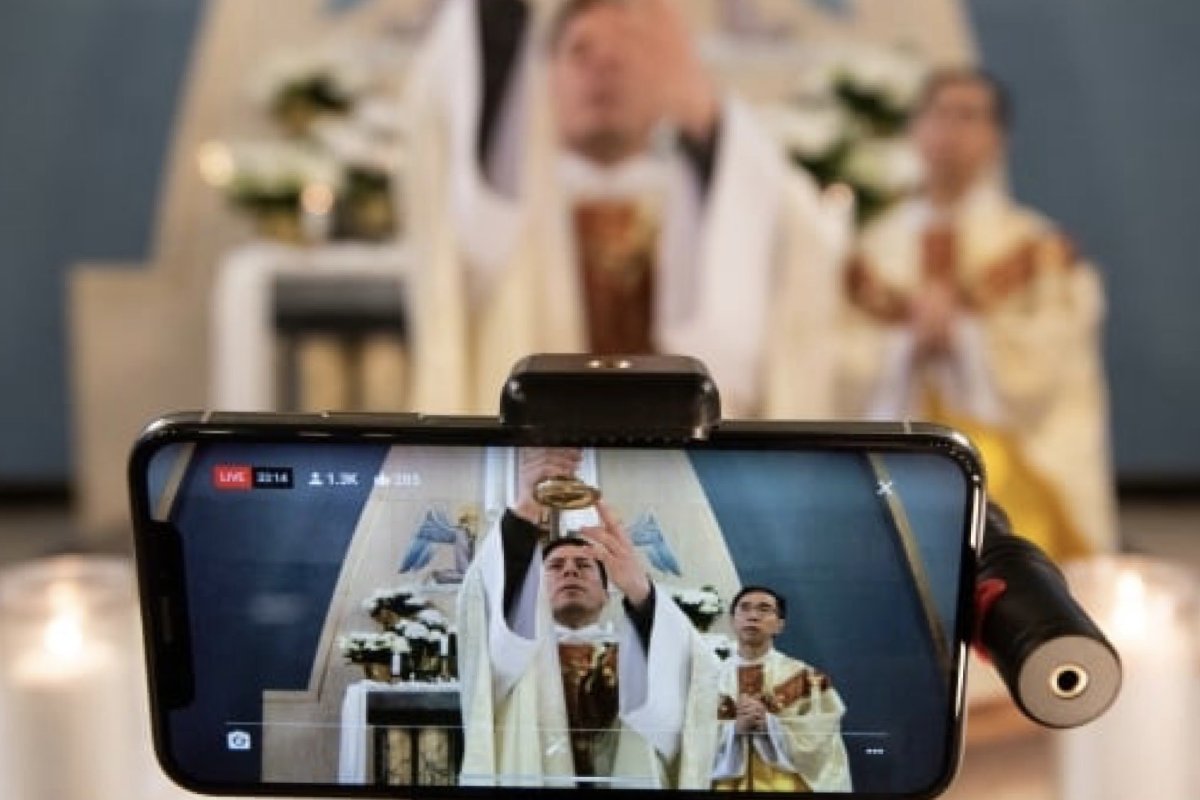
Tools for Studying Pandemic Religion
What can we learn from the field of human-computer interaction (HCI) about sighting and understanding religion during and after the pandemic?
In 1959, an electrical engineer named Paul Baran proposed a robust communication network capable of surviving nuclear assault. Long-distance telephone systems, dependent upon centralized switching facilities, were vulnerable in the event of nuclear war. So Baran designed a way to route information through a decentralized network of unmanned nodes. Ultimately, Baran’s design helped create the internet.
While the nuclear threats of the Cold War era have waned, the world is now contending with the viral threats of COVID-19, and this time of global pandemic is revealing the necessity of Baran’s decentralized communication network for our social and individual lives.
According to a recent article in Technology Review, Coronavirus quarantines have led to a precipitous rise in internet usage. The COVID-19 era is also transforming patterns of internet use. More people are using the internet more often and in increasingly inventive ways.
In keeping with this trend, religious communities have relied heavily on internet technologies during this global pandemic. Jewish communities conducted virtual Seders and bar mitzvahs. Sikh communities live-streamed Vaisakhi celebrations. Christian churches offered Easter worship services online. Muslims gathered remotely on Zoom for the month of Ramadan. While many religious traditions have previously used digital technology for spiritual purposes, the coronavirus pandemic has greatly amplified these practices by necessity.
Scholars of religion understand the importance of material culture and embodied practices. Studying religion in the era of COVID-19, therefore, must involve the complex interactions between individuals, religious communities, and the digital technologies that they use. The role of computers, internet connections, online spaces, and digital interfaces are increasingly important to the academic study of religion. This presents new possibilities and places of inquiry. And this poses new methodological questions and challenges.
Those seeking to understand religion in the COVID-19 era, therefore, might do well to pay attention to developments in the field of human-computer interaction (HCI). Emerging as a discipline over the past forty years, HCI is an interdisciplinary field concerned with interactive computing systems for human use. Beginning as a specialty within computer science, HCI has increasingly focused on the human side of computational devices such as computers, smartphones, and tablets. According to Shaowen Bardzell, “HCI continues to expand beyond the preoccupations with how efficiently a system performs and is becoming increasingly concerned with culture, society, and interested in the experiential qualities of computing.”[1]
HCI research analyzes the ways in which human users and communities interact with technologies in specific contexts of use. This includes studying users’ emotional and social drives, motivations, and behaviors. This humanistic emphasis means that certain HCI concepts and research methodologies can be of considerable value to scholars of religion. The HCI toolbox of research methods—especially now that COVID-19 is generating a panoply of new online religious practices—offers several valuable resources for researching digitally mediated religious practices.
A “diary study” is one such research method within the HCI toolbox. This qualitative research technique asks participants to record details relative to specific actions or interactions. For instance, a diary study could ask participants to self-report behaviors, thoughts, or emotions over a month of attending online worship services. This qualitative data offers an intimate insight into users’ behaviors, attitudes, and experiences with digital technology over time.
“Think-aloud protocol” is yet another possible HCI research technique that could be used by scholars of religion. Participants in a think-aloud are asked to verbally articulate all thoughts, feelings, and questions encountered while using a particular digital interface. This allows the researcher to better understand the user experience. A scholar of religion could use a think-aloud protocol to study how a particular digital interface influences certain online religious practices. For example, this technique could analyze how users experience virtual bar mitzvahs or Bible studies.
“Experience mapping” may also be useful to scholars of religion. This user-experience technique visually depicts the major touchpoints involved as a user completes a multistep or complex task. Mapping the end-to-end experiences of users, this provides a visual timeline of interactions. For instance, one might use an experience map to better understand the end-to-end experience of a live-stream funeral service. The experience map would include touchpoints such as initially scheduling the service, communicating with religious leaders, notifying family and friends, and accessing the platform for the virtual service itself.
Scholars of religion may be familiar with these or similar research techniques from the academic field of digital humanities. The digital humanities and HCI are indeed closely related. While there are many similarities, there are also certain differences. According to Jeffery Bardzell and Shawowen Bardzell, humanistic HCI is “research or practice that deploys humanistic epistemologies (e.g., theories and conceptual systems) and methodologies (e.g., critical analysis of designs, processes, and implementations; historical genealogies; conceptual analysis; emancipatory criticism) in service of HCI processes, theories, methods, agenda setting, and practices. It is not the same as digital humanities, which is humanistic research supported by digital technologies, and which is by and large practiced by humanistic scholars.”
Before COVID-19, digital interactions only partially mediated people’s connections with others in the realm of religion. At this moment, however, digital interactions mediate nearly every connection we have with others in terms of our religious lives. As scholars of religion continue their work in the post-pandemic age, it will be increasingly important to understand the complex interactions between individuals, religious communities, and the digital technologies that bring them together.
[1] Shaowen Bardzell (2010), “Feminist HCI: Taking stock and outlining an agenda for design.” Conference on Human Factors in Computing Systems - Proceedings. 2. 1301-1310. 10.1145/1753326.1753521.
Image: Father Mark Goring at St. Mary's Parish Catholic church in Ottawa (Canada) celebrates the Eucharist in front of an iPhone broadcasting the mass live on April 12, 2020. (Photo Credit: Justin Tang)
Sightings is edited by Joel Brown, a PhD Candidate in Religions in the Americas at the Divinity School. Sign up here to receive Sightings via email. You can also follow us on Facebook and Twitter. The views and opinions expressed in this article are those of the author and do not necessarily reflect the position of the Marty Center or its editor.


